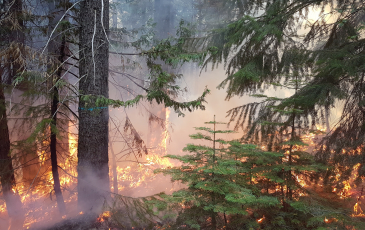Worried About Dead Trees in California Forests? Blame Fire Suppression
"Fire suppression has caused a change in forest structure, and that change is interacting with changes in climate, to drive mortality," says Stephens. But the story gets a bit more complicated still, because it's rarely thirst itself that kills the trees.
Grouse Ridge Forest Easement for Bear Yuba Land Trust PG&E Land Donated to UC
As part of its land conservation commitment, Pacific Gas and Electric Company (PG&E) recently donated 1,459 acres to the University of California (UC). The transfer was immediately followed by the conveyance of a conservation easement to Bear Yuba Land Trust (BYLT), permanently protecting high-country forest land and important wildlife habitat.
Drones help monitor health of giant sequoias
Todd Dawson’s field equipment always includes ropes and ascenders, which he and his team use to climb hundreds of feet into the canopies of the world’s largest trees, California’s redwoods.
It’s laborious work, but he’ll soon be getting a little help. From drones.
Study Finds Surprising Culprit Drives Forest Fire Behavior
Temperatures are rising and forest fires, already larger and more frequent than the historical norm, are projected to increase dramatically with anthropogenic warming. But a study released last week found an influence on past fire activity even greater than climate: human beings. The way humans have used land in the Sierra has had more effect on fire behavior than climate change.
New Aerial Survey Identifies More Than 100 Million Dead Trees in California
The U.S. Department of Agriculture (USDA) announced today that the U.S. Forest Service has identified an additional 36 million dead trees across California since its last aerial survey in May 2016. This brings the total number of dead trees since 2010 to over 102 million on 7.7 million acres of California's drought stricken forests.
Let It Burn: The Forest Service Wants to Stop Putting Out Some Fires
California’s fire season hasn’t turned out to be as bad as some feared this year. Stephens says today there’s actually a fire deficit.
Sierra Nevada forests are adapted to low-intensity fires that clear the underbrush and prevent trees from getting too dense. After a century of fire suppression, many forests are overgrown, which can make catastrophic fires worse.
U.S. federal fire and forest policy: emphasizing resilience in dry forests
New research from Scott Stephens, Brandon Collins, Eric Biber, and Peter Fule

![[news image] Dead trees and river by Carlin Starrs [news image] Dead trees and river by Carlin Starrs](https://forests.berkeley.edu/sites/forests.berkeley.edu/files/styles/news_river/public/2014-10-22%2012.00.26.jpg?itok=-adYBLc2)
![[news image] Blodgett view by Ariel Thomson [news image] Blodgett view by Ariel Thomson](https://forests.berkeley.edu/sites/forests.berkeley.edu/files/styles/news_river/public/20180509_105346.jpg?itok=JFH_-i7I)
![[news image] Blodgett in snow by Ariel Thomson [news image] Blodgett in snow by Ariel Thomson](https://forests.berkeley.edu/sites/forests.berkeley.edu/files/styles/news_river/public/20180126_084503.jpg?itok=pNSyt9GK)
